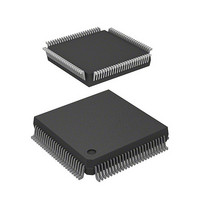HD6417032F20 Renesas Electronics America, HD6417032F20 Datasheet - Page 198

HD6417032F20
Manufacturer Part Number
HD6417032F20
Description
IC SUPERH MPU ROMLESS 112QFP
Manufacturer
Renesas Electronics America
Series
SuperH® SH7030r
Datasheet
1.HD6417034AFI20.pdf
(689 pages)
Specifications of HD6417032F20
Core Processor
SH-1
Core Size
32-Bit
Speed
20MHz
Connectivity
EBI/EMI, SCI
Peripherals
DMA, POR, PWM, WDT
Number Of I /o
32
Program Memory Type
ROMless
Ram Size
4K x 8
Voltage - Supply (vcc/vdd)
4.5 V ~ 5.5 V
Data Converters
A/D 8x10b
Oscillator Type
Internal
Operating Temperature
-20°C ~ 75°C
Package / Case
112-QFP
Lead Free Status / RoHS Status
Contains lead / RoHS non-compliant
Eeprom Size
-
Program Memory Size
-
Available stocks
Company
Part Number
Manufacturer
Quantity
Price
Company:
Part Number:
HD6417032F20
Manufacturer:
HIT
Quantity:
5 510
Company:
Part Number:
HD6417032F20
Manufacturer:
AMCC
Quantity:
5 510
Company:
Part Number:
HD6417032F20
Manufacturer:
Renesas Electronics America
Quantity:
10 000
Part Number:
HD6417032F20
Manufacturer:
HITACHI/日立
Quantity:
20 000
Company:
Part Number:
HD6417032F20V
Manufacturer:
TI
Quantity:
201
- Current page: 198 of 689
- Download datasheet (5Mb)
Section 8 Bus State Controller (BSC)
8.10.1
If there is conflict between bus arbitration and refreshing, the operation is as follows.
1. If DRAM refreshing is requested in this chip when the bus is released and BACK is low,
2. When BREQ changes from high to low and an internal refresh is requested at the timing of bus
Rev. 7.00 Jan 31, 2006 page 170 of 658
REJ09B0272-0700
BREQ
BACK
BACK goes high and the occurrence of the refresh request can be indicated externally. At this
time, the external device may generate a bus cycle when BREQ is low even if BACK is high.
Therefore, the bus remains released to the external device. Then, when BREQ goes high, this
chip acquires bus ownership, and executes a refresh and the bus cycle of the CPU or DMAC.
After the external device acquires bus ownership and BACK is low, a refresh is requested
when BACK goes high even if BREQ input is low. Therefore, drive BREQ high immediately
to release the bus for this chip to hold DRAM data (see figure 8.36).
release by this chip, BACK may remain high. The bus is released to the external device since
BREQ input is low. This operation is based on the above specification (1). To hold DRAM
data, drive BREQ high and release the bus to this chip immediately when the external device
detects that BACK does not change to low during a fixed time (see figure 8.37). When a
refresh request is generated and BACK returns to high, as shown in figure 8.37, a momentary
narrow pulse-shaped spike may be output where BACK was originally supposed to go low.
Operation of Bus Arbitration
Figure 8.36 BACK
BACK Operation in Response to Refresh Demand (1)
BACK
BACK
Refresh demand
Refresh execution
Related parts for HD6417032F20
Image
Part Number
Description
Manufacturer
Datasheet
Request
R

Part Number:
Description:
KIT STARTER FOR M16C/29
Manufacturer:
Renesas Electronics America
Datasheet:

Part Number:
Description:
KIT STARTER FOR R8C/2D
Manufacturer:
Renesas Electronics America
Datasheet:

Part Number:
Description:
R0K33062P STARTER KIT
Manufacturer:
Renesas Electronics America
Datasheet:

Part Number:
Description:
KIT STARTER FOR R8C/23 E8A
Manufacturer:
Renesas Electronics America
Datasheet:

Part Number:
Description:
KIT STARTER FOR R8C/25
Manufacturer:
Renesas Electronics America
Datasheet:

Part Number:
Description:
KIT STARTER H8S2456 SHARPE DSPLY
Manufacturer:
Renesas Electronics America
Datasheet:

Part Number:
Description:
KIT STARTER FOR R8C38C
Manufacturer:
Renesas Electronics America
Datasheet:

Part Number:
Description:
KIT STARTER FOR R8C35C
Manufacturer:
Renesas Electronics America
Datasheet:

Part Number:
Description:
KIT STARTER FOR R8CL3AC+LCD APPS
Manufacturer:
Renesas Electronics America
Datasheet:

Part Number:
Description:
KIT STARTER FOR RX610
Manufacturer:
Renesas Electronics America
Datasheet:

Part Number:
Description:
KIT STARTER FOR R32C/118
Manufacturer:
Renesas Electronics America
Datasheet:

Part Number:
Description:
KIT DEV RSK-R8C/26-29
Manufacturer:
Renesas Electronics America
Datasheet:

Part Number:
Description:
KIT STARTER FOR SH7124
Manufacturer:
Renesas Electronics America
Datasheet:

Part Number:
Description:
KIT STARTER FOR H8SX/1622
Manufacturer:
Renesas Electronics America
Datasheet:

Part Number:
Description:
KIT DEV FOR SH7203
Manufacturer:
Renesas Electronics America
Datasheet:











